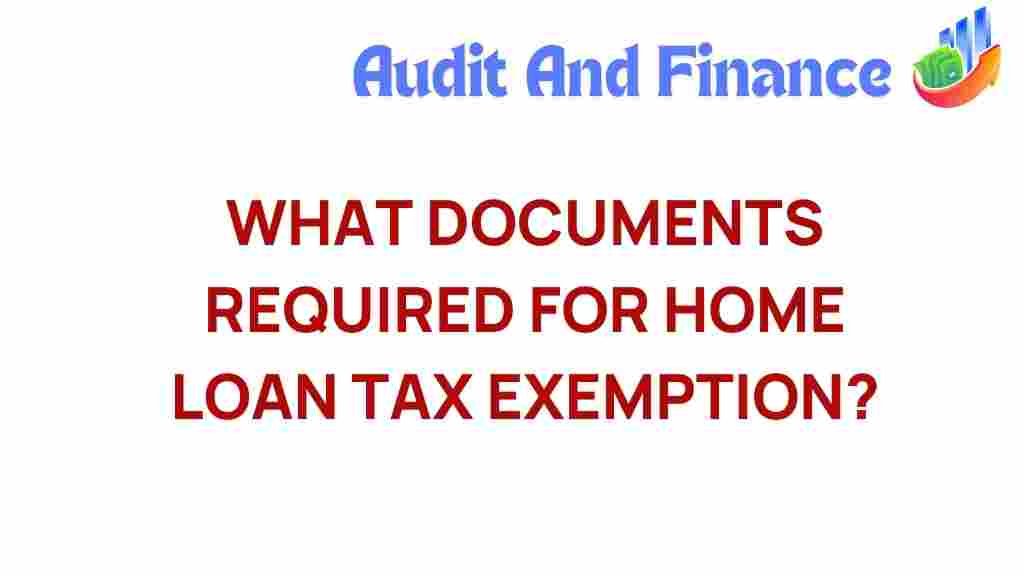Unlocking Home Loan Tax Exemption: Essential Documents You Need
Owning a home is one of the most significant financial milestones in a person’s life. Not only does it provide a sense of security, but it also comes with various financial benefits, including tax exemptions on home loans. Understanding the documents required for claiming these exemptions is crucial in maximizing your tax savings. In this article, we’ll delve into the essential paperwork you need to unlock home loan tax exemptions, the eligibility criteria, and how you can benefit financially from these provisions.
Understanding Home Loan Tax Exemption
A home loan tax exemption allows borrowers to deduct certain amounts from their taxable income. This not only reduces your tax liability but also enhances the overall affordability of home ownership. The tax exemptions typically apply to the principal repayment and the interest paid on the home loan, making it essential to understand the documents required to claim these benefits.
Financial Benefits of Home Loan Tax Exemption
- Reduces taxable income, thereby lowering tax liabilities.
- Encourages investment in real estate and promotes home ownership.
- Provides financial relief during the repayment period.
- Incentivizes individuals to invest in their homes rather than renting.
Documents Required for Home Loan Tax Exemption
To qualify for tax exemption on your home loan, it is important to have the correct documents required in place. Here’s a detailed list of the necessary paperwork:
1. Home Loan Statement
Your lender will provide you with an annual home loan statement, which outlines the total interest and principal paid during the financial year. This statement is crucial for calculating your tax benefits.
2. Form 16 or Income Tax Return
Form 16 is a certificate issued by your employer, detailing your salary and tax deductions. If you are self-employed, you will need to furnish your income tax return (ITR). This document is essential to prove your income and calculate your tax liability.
3. Agreement for Sale/Property Papers
Having the property documents, including the sale agreement, is essential. These documents prove your ownership and the legitimacy of your claim for the home loan tax exemption.
4. Payment Receipts
Keep the receipts for all payments made towards the home loan, including EMIs and any pre-payments. These receipts should be maintained for claiming tax deductions.
5. Tax Registration Documents
Ensure that your property is registered with the local authorities. Having the tax registration documents can further validate your claims and support your tax exemption request.
6. NOC from the Lender
A No Objection Certificate (NOC) from your lender can also be useful, especially if you have settled your loan. This document confirms that there are no pending dues.
7. Additional Documents for Joint Home Loans
If you have taken a joint home loan, ensure that the co-borrower provides the necessary documentation as well. This may include:
- Co-borrower’s Form 16 or ITR
- Co-borrower’s identity proof
Step-by-Step Process to Claim Home Loan Tax Exemption
Now that you have the necessary documents required, here’s a step-by-step process to claim your home loan tax exemption:
Step 1: Gather Required Documents
Start by collecting all the aforementioned documents. Ensure they are up-to-date and accurately reflect your financial status and home ownership.
Step 2: Calculate Your Eligible Deductions
Determine the amount you can claim as a deduction. Under Section 80C, you can claim deductions on the principal repayment (up to ₹1.5 lakh per annum) and under Section 24(b) for interest paid (up to ₹2 lakh per annum for self-occupied properties).
Step 3: Complete Your Income Tax Return
When filling out your income tax return, include the deductions calculated. Ensure that the information is accurate and corresponds with the documents you have collected.
Step 4: Submit Your Tax Return
File your income tax return before the due date. You can do this online through the official income tax website or through tax filing services.
Step 5: Keep Records
Post-filing, maintain a record of all documents submitted, as they may be required for future reference or in case of an audit.
Troubleshooting Tips for Home Loan Tax Exemption
While claiming tax exemptions can be straightforward, there may be challenges along the way. Here are some tips to troubleshoot common issues:
1. Missing Documents
If you realize you’re missing any documents required, contact your lender immediately to obtain the necessary paperwork.
2. Incorrect Deductions
Double-check your calculations. If you’re unsure, consider consulting a tax advisor or financial expert to ensure your claims are accurate.
3. Delayed Filing
If you miss the tax filing deadline, you can still file a belated return. However, penalties may apply. Ensure you file as soon as possible to minimize financial repercussions.
4. Audit Queries
In the event of an audit, be prepared to present all the documents supporting your claims. Maintain organized records to facilitate a smooth process.
Conclusion
Unlocking the financial benefits of home loan tax exemptions requires careful attention to the documents required and the eligibility criteria. By understanding the necessary paperwork and following the steps outlined in this article, you can maximize your tax savings and enjoy the advantages of home ownership. Remember, staying organized and informed is key to a successful tax exemption claim.
For further information on home loans and tax exemptions, you may visit the official government website or consult a financial advisor.
To learn more about home ownership and mortgage options, check out our detailed guide here.
This article is in the category Taxation and created by AuditAndFinance Team
